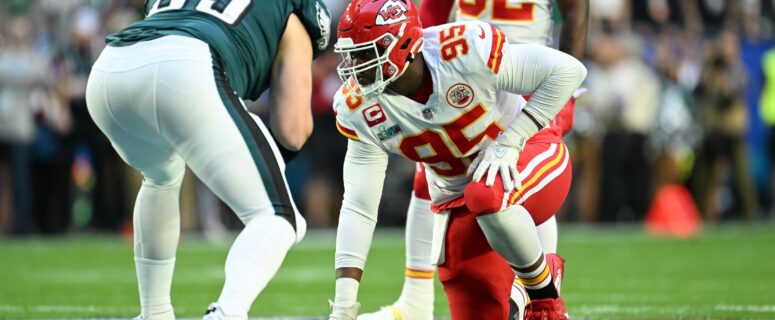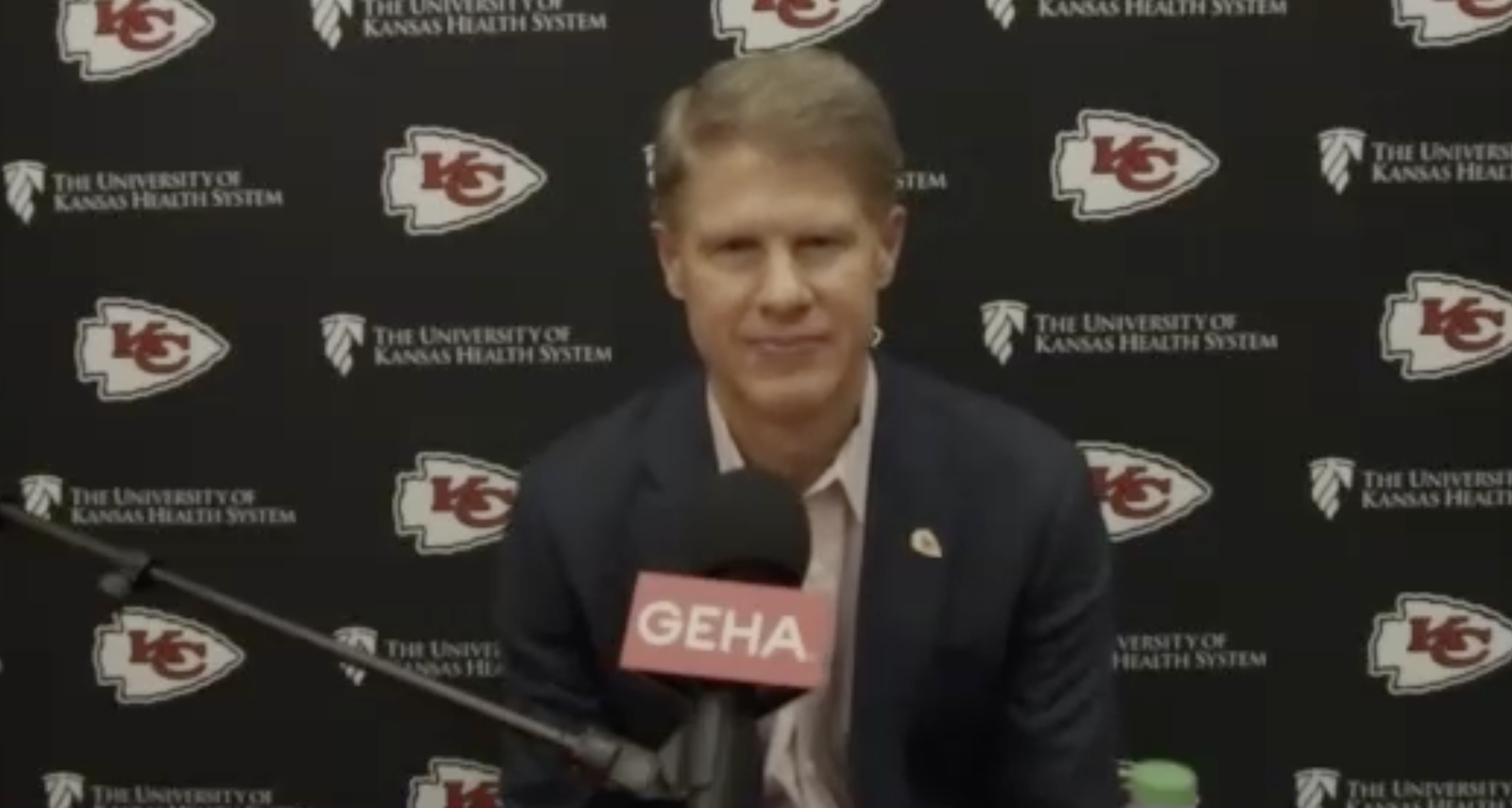ST. JOSEPH, Mo. – Just more than six years after becoming general manager of the Chiefs, not much surprises Brett Veach anymore. But with Chris Jones missing the first 20 days of training camp and piling up $1 million in fines, Veach paused before answering whether Jones’ holdout caught him off guard.
“I have a different perspective, because on one end, certainly, (we) are working hard to keep her Chris, and certainly want him here,” Veach told Chiefs Digest. “On the other end (I) absolutely respect the business side of things. Whatever a player and his agent, whatever I guess their approach and how they do things, he’s earned that right, in regards to what he thinks is best for him and his future.”
There is little doubt that the best future for the Chiefs and Jones is staying together. Veach hasn’t given any thought to trading Jones – in fact, the plan of re-signing Jones traces back to March 2022 when the club opted to trade receiver Tyreek Hill rather than ink him top a market-resetting contract. Even when the team entered free agency this March with the additions of offensive tackle Jawaan Taylor and defensive end Charles Omenihu, the club allowed the likes of Orland Brown Jr., JuJu Smith-Schuster, Andrew Wylie, Juan Thornhill, Khalen Saunders, Frank Clark and Mecole Hardman to depart so they could work out an extension with Jones.
“I think when we started this process back in the spring our goal, we had some priorities to check off the box,” Veach said. “Right at the top was Chris Jones, and I don’t think we’ve ever wavered from that mindset.”
But the Jones holdout puts many of the other team’s plans and priorities on hold. The NFL Players Association public salary cap report listed the Chiefs with $344,569 of cap space. At this time of year, the formula counts only a team’s top 51 players. It doesn’t count the last two players on the roster, nor does it include players on injured reserve or the practice squad. The Chiefs have enough cap space to sign precisely one of 16 practice squad players.
Significant savings could be found by signing Jones to a new extension. He’s due $19.5 million in base salary this season. A new contract could free up as much as $10 to $15 million in cap space.
A new extension would also allow Veach to know how much cap budget to allot toward his All-Pro defensive tackle in 2024 and beyond. And that’s where the holdout of Jones throws a wrench into Veach’s plans. Veach steadfastly maintains his philosophy on roster building is simple.
“I think the goal is to obviously, build through the draft, be selective in free agency,” Veach said. “When you have an opportunity to extend the guys that have been here in part of that core foundation to do that.”
When it comes to retaining players the Chiefs drafted beyond their rookie contracts, the club has a spotty recent track record. The optimal time to re-sign such players is after their third year before they head into the “contract year.” After four accrued seasons in the league, players can choose to test free agency with only the franchise tag as potential leverage.
Since the 2015 NFL Draft – the first class which reached three seasons under Veach’s watch as general manager – the Chiefs have only signed two players to an extension immediately after their third season in the league. The first was wide receiver Tyreek Hill, who signed an extension in 2019 that would keep him in Kansas City for two additional seasons beyond his rookie contract. The other was Patrick Mahomes, who signed a 10-year, $450 million extension in 2020.
Jones also signed an extension with the club in 2020 but only after his fourth season and with the team wielding the leverage of the franchise tag. Others such as receiver Demarcus Robinson, defensive tackle Derrick Nnadi and offensive lineman Nick Allegretti returned to the Chiefs on one-year deals after their rookie contracts expired. But that’s not an indication that Veach’s belief in building through the draft has eroded in any way.
“From a philosophical standpoint, that hasn’t changed,” Veach said. “I think that anytime you have a draft class, and these guys play well on their rookie contract, you have the fact that you’ve seen their maturation and growth, but then you have the fact that you get to keep in the system, and that’s so critically important. We did have a coaching staff change on the defensive side during that run. But as far as the growth and development on that side, it’s a little bit different with some draft classes.”
Indeed now the Chiefs are entering an era where high-performing draft classes have candidates entering the extension zone. The club can right now negotiate extensions with 2020 first-round running back Clyde Edwards-Helaire, linebacker Willie Gay, offensive tackle Lucas Niang, cornerback L’Jarius Sneed, defensive end Michael Danna and punter Tommy Townsend.
And coming Jan. 8, 2024, Veach can sign extensions with one of the club’s richest draft classes in memory headlined by Nick Bolton, Creed Humphrey, Trey Smith and Noah Gray.
“We’ve been fortunate the last few years and we’ve had some really, really good draft classes come together,” Veach said. “Now these guys are hitting their window and we have a bunch of them coming up next year.”
But none of that can happen without a resolution of the Jones contract situation. The Chiefs have no salary cap wiggle room in 2023 without an extension for Jones. And it’s impossible to build a budget blueprint for paying the likes of Bolton, Humphrey and Smith in 2025, 2026 and 2027 without knowing how many cap dollars Jones will consume in those seasons.
“That’s a little bit of a challenge for us,” Veach said. “Usually when you get the big pieces of the puzzle put away and can account for how their flows will be allotted, you’re able to really work in definitives. And so I think once we can work through the Chris Jones thing and get a resolution there, then I think everything kind of falls into place for those guys.
“It’s like anything, you start with the big ones and you want to make sure that you’re not putting yourself in any future problematic issues down the road with some of the cap construction stuff.”
While securing the future of Jones in Kansas City topped Veach’s to-do list in 2023, his next agenda is retaining the team’s young nucleus.
“I certainly think that that will always be a priority,” Veach said. “Maybe the first few years it didn’t go that route and the roster was composed different ways, but the level of play from these young guys coming up, it’s going to be something that’s right at the forefront of our priorities.”
For that to happen, the Jones puzzle piece must first fall into place. Rather than rush into a deal, both sides want to see where the market for defensive tackle would find equilibrium. Last month, New York Jets defensive tackle Quinnen Williams signed a four-year, $96 million extension averaging $24 million per year. The next highest-paid player at that position is Aaron Donald of the Los Angeles Rams, whose three-year, $95 million deal averages $31.67 million per season. A deal for Jones will likely land in between, and Veach isn’t afraid to wait, even if it holds up his other plans for the team’s future.
“I think we are truly diligent and methodical,” Veach explained. “I don’t know if it’s an oxymoron to say we’re aggressively methodical. But we always have aggressive plans. But we also know that if you make your moves too soon sometimes you get caught in a bind. We didn’t want to do that.”
Veach stresses the team has had positive communication with Jones’ representatives. With each passing day, however, that equation could alter dramatically.
“Ultimately, as we get closer to the season, the dynamic changes in regards to just the way it’s set up,” Veach said. “You don’t want to see him lose any money and you don’t want to see him get fined. Everyone in this building loves Chris. So, the rules are predetermined in regard to the fines and all that kind of stuff. We don’t want to see that happen. And as it gets closer, you feel like, just naturally, things have to come to a head. But, you know, we’re, again, cautiously optimistic.”


